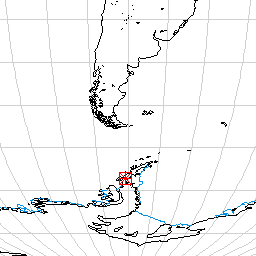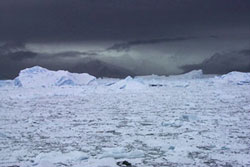 |
|
|
 |
Lallemand Fjord, 67 10 south, 66 40 west, foggy & snow, -1.8 C
We have had a great day of science following our long trip across the Drake Passage. We arrived in the Crystal Sound area around midnight and began using the bottom profiling equipment to locate a deep basin that had been noted in this area but never sampled. Around 5 am this morning (ship time) we lowered a Kasten core over the side in 1238 meters of water.
The Kasten core is a 10 foot long by 6 inch by 5 inch rectangular tube with removable panels on one side. It has a sharpened hardened steel cutter nose on the bottom and 1200 pounds of weight on the top. Picture a pencil standing vertically with removable panels up one of the faces from bottom to top. In the cutter nose are a couple of one way flaps that fold up into the core as it is being lowered and swing closed when loaded from inside the core. The Kasten Core is lowered on a cable, a very long, strong cable, and buries itself in the mud on the bottom. This is basically a free fall at around 50 meters per minute. There is no way to tell what it hits and it's possible that it hits a rock, bounces and tips over, collecting nothing. The hope is that it buries itself in the mud. The cable is raised at around 20 meters a minute, so with say 1250 meters of cable out it takes a long time to get that back on board. This mornings core was a beautiful one. Sediment filled the entire 10 feet of the core and once on board the various scientists went to work. The covers are removed and the core is photographed and described. After that, small samples are collected every 3-5 cm for the full length, These will be used to measure water content, organic content and other properties. A second, larger set of samples is taken for Carbon 14 age dating. Others take smears of the mud to look for forams.
Oriented cubes are taken to measure the remnant magnetism and it's direction, Pore water samples are collected to measure CO2 content and water chemistry. Finally archive sections are taken, that will be shipped to Florida State University which archives all Antarctic cores. At FSU the archive sections are x rayed to show the stratigraphy of the various layers layed down over time. The general consensus is that this 10 feet of mud and ooze represents 5000 years of sedimentation in this area. In other words the mud at the bottom of the core is 5000 years old!
We have had a great day of science following our long trip across the Drake Passage. We arrived in the Crystal Sound area around midnight and began using the bottom profiling equipment to locate a deep basin that had been noted in this area but never sampled. Around 5 am this morning (ship time) we lowered a Kasten core over the side in 1238 meters of water.
The Kasten core is a 10 foot long by 6 inch by 5 inch rectangular tube with removable panels on one side. It has a sharpened hardened steel cutter nose on the bottom and 1200 pounds of weight on the top. Picture a pencil standing vertically with removable panels up one of the faces from bottom to top. In the cutter nose are a couple of one way flaps that fold up into the core as it is being lowered and swing closed when loaded from inside the core. The Kasten Core is lowered on a cable, a very long, strong cable, and buries itself in the mud on the bottom. This is basically a free fall at around 50 meters per minute. There is no way to tell what it hits and it's possible that it hits a rock, bounces and tips over, collecting nothing. The hope is that it buries itself in the mud. The cable is raised at around 20 meters a minute, so with say 1250 meters of cable out it takes a long time to get that back on board. This mornings core was a beautiful one. Sediment filled the entire 10 feet of the core and once on board the various scientists went to work. The covers are removed and the core is photographed and described. After that, small samples are collected every 3-5 cm for the full length, These will be used to measure water content, organic content and other properties. A second, larger set of samples is taken for Carbon 14 age dating. Others take smears of the mud to look for forams.
Oriented cubes are taken to measure the remnant magnetism and it's direction, Pore water samples are collected to measure CO2 content and water chemistry. Finally archive sections are taken, that will be shipped to Florida State University which archives all Antarctic cores. At FSU the archive sections are x rayed to show the stratigraphy of the various layers layed down over time. The general consensus is that this 10 feet of mud and ooze represents 5000 years of sedimentation in this area. In other words the mud at the bottom of the core is 5000 years old!

As we sailed into Lallemand Fjord this morning the surface was a complete mash of icebergs and ice chunks, with no open water to be seen. Just to make for a complete change from last year when it was sunny, we were in a good sized snowstorm. The plan for recovering these was to locate them with the botom profiling equipment, basically a high end fish finder, and then catch the rope with a grapple. The very experienced crew on the ship has currently recovered 2 of the moorings and is bringing up the third now.
This is pretty amazing when you consider that they were able to catch these devices in over 200 meters of water, with a hook on the end of a cable.
Asa, the doctoral student who's dissertation depends on these sediment traps, was very happy to see them come on board. She said she's been
nervous about this for the whole year they've been in the water.
It's currently 9:45 pm ship time, we have been up since 5 am working on the core and the sediment traps. Once we get the third mooring up we will move to another area to collect water at various depths for the water chemists on board, then it's off to the area we took the Kasten core this morning to collect another core on our way out of this area and onto the next major sampling site.
I guess the last really puts the day in perspective. We've been working so hard the science got mentioned before the view. It's been cloudy with on and off snowstorms all day. We are in a narrow Fjord, packed with tabular icebergs and chunks off the icebergs. Occasional bergs have a seal of two lying on them and Storm Petrels and Skua Gulls are in the air overhead. When the clouds lift a little we are surrounded by high mountains with glacier/icesheets flowing down them. There is a little exposed dark rock but mostly the tones are white, off white and a deep blue of the icebergs. On the ridges of the peaks you can see the snow blowing out in large plumes and cornice lips developed in some areas. There is no evidence of any avalanches on these slopes.
We were all taken by the sound the ship makes plowing through the ice. It is difficult to describe and I figure if two professional writers on board, one from Discover Magazine and one from the New Scientist, were discussing how they were ever going to convey the sights and sounds of today then there is little hope for me.
Finally, April 1st did not go unnoticed on the ship. Last night the Captain called the two chief scientists Eugene Domack from Hamilton and Amy Leventer from Colgate University to a special meeting. At the meeting he informed them that he had just received emergency orders. The Gould, another research ship in the Antarctic, had struck an iceberg and was disabled on the other side of the Palmer Pennisula in the Weddell Sea. The Palmer was the closest ship and was to abandon all science work and proceed full speed to the Goulds aid. The Captain even had charts prepared for the course to the Weddell and a stack of faxes supposedly ordering him to the Gould's aid. Needless to say after 3.5 days of transit here and no cores having been collected yet this news did not sit will with the two of them. The Captain strung them on for a while before letting them in on the April Fools joke.
Cheers, Dave
|
|
 |